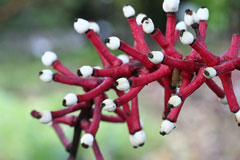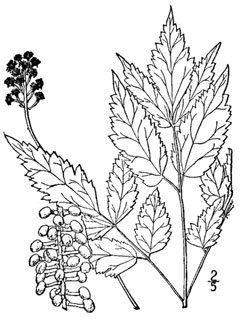 |
|
http://www.flickr.com/photos/36521977367@N01/282258648 |
 |
|
Translate this page:
Summary
Physical Characteristics

 Actaea pachypoda is a PERENNIAL growing to 0.8 m (2ft 7in) by 0.5 m (1ft 8in).
Actaea pachypoda is a PERENNIAL growing to 0.8 m (2ft 7in) by 0.5 m (1ft 8in).
See above for USDA hardiness. It is hardy to UK zone 3. It is in flower from June to July, and the seeds ripen in August. The species is hermaphrodite (has both male and female organs).
Suitable for: light (sandy), medium (loamy) and heavy (clay) soils. Suitable pH: mildly acid, neutral and basic (mildly alkaline) soils. It can grow in semi-shade (light woodland). It prefers moist soil.
UK Hardiness Map
US Hardiness Map
Synonyms
A. pachypoda. Elliott.
Plant Habitats
Woodland Garden Dappled Shade;
Edible Uses
References More on Edible Uses
Medicinal Uses
Plants For A Future can not take any responsibility for any adverse effects from the use of plants. Always seek advice from a professional before using a plant medicinally.
Antipruritic Antirheumatic Emmenagogue Galactogogue Hypnotic Oxytoxic Stimulant VD
The whole plant, but especially the root, is anticonvulsive, antirheumatic, emmenagogue, mildly hypnotic, oxytocic and stimulant[207, 257]. Use with caution, see the notes above on toxicity[222]. A decoction of the roots has been used in the treatment of coughs, colds, rheumatism and syphilis[213, 257]. It is also used in small doses to ease the pain of childbirth[222] and is used as a stimulant to revive and rally patients at the point of death[257]. An infusion of the roots has been used externally to treat itchy skin and as a gargle for sore throats[257]. An infusion of leaves was drunk by the women of some Indian tribes in order to stimulate the flow of milk[213].
References More on Medicinal Uses
The Bookshop: Edible Plant Books
Our Latest books on Perennial Plants For Food Forests and Permaculture Gardens in paperback or digital formats.

Edible Tropical Plants
Food Forest Plants for Hotter Conditions: 250+ Plants For Tropical Food Forests & Permaculture Gardens.
More

Edible Temperate Plants
Plants for Your Food Forest: 500 Plants for Temperate Food Forests & Permaculture Gardens.
More

More Books
PFAF have eight books available in paperback and digital formats. Browse the shop for more information.
Shop Now
Other Uses
References More on Other Uses
Cultivation details
Tolerates most conditions[233], but prefers a humus-rich moist soil in light shade[200, 233]. Grows best in the wild or woodland garden[200]. This species is closely related to A. rubra[200].
References Carbon Farming Information and Carbon Sequestration Information
Temperature Converter
Type a value in the Celsius field to convert the value to Fahrenheit:
Fahrenheit:
The PFAF Bookshop
Plants For A Future have a number of books available in paperback and digital form. Book titles include Edible Plants, Edible Perennials, Edible Trees,Edible Shrubs, Woodland Gardening, and Temperate Food Forest Plants. Our new book is Food Forest Plants For Hotter Conditions (Tropical and Sub-Tropical).
Shop Now
Plant Propagation
Seed - best sown as soon as it is ripe in the autumn in a cold frame or in a sheltered outdoor bed[200]. Completely remove the seed pulp since this can inhibit germination. Stored seed does not usually germinate well[200]. When they are large enough to handle, prick the seedlings out into individual pots and plant them out into their permanent positions in late spring or early summer of the following year. Division in spring.
Other Names
If available other names are mentioned here
Native Range
NORTHERN AMERICA: Canada (Québec (south), Nova Scotia, Ontario (south), Prince Edward Island, New Brunswick), United States (Connecticut, Indiana, Maine, Massachusetts, Michigan, New Hampshire, New Jersey, New York, Ohio, Pennsylvania, Rhode Island, Vermont, West Virginia, Illinois, Iowa, Minnesota (east), Missouri, Oklahoma, Wisconsin, Alabama, Arkansas, Delaware, Florida, Georgia, Kentucky, Maryland, Mississippi, North Carolina, South Carolina, Tennessee, Virginia)
Weed Potential
Right plant wrong place. We are currently updating this section.
Please note that a plant may be invasive in one area but may not in your area so it's worth checking.
Conservation Status
IUCN Red List of Threatened Plants Status :

Growth: S = slow M = medium F = fast. Soil: L = light (sandy) M = medium H = heavy (clay). pH: A = acid N = neutral B = basic (alkaline). Shade: F = full shade S = semi-shade N = no shade. Moisture: D = dry M = Moist We = wet Wa = water.
Now available:
Food Forest Plants for Mediterranean Conditions
350+ Perennial Plants For Mediterranean and Drier Food Forests and Permaculture Gardens.
[Paperback and eBook]
This is the third in Plants For A Future's series of plant guides for food forests tailored to
specific climate zones. Following volumes on temperate and tropical ecosystems, this book focuses
on species suited to Mediterranean conditions—regions with hot, dry summers and cool, wet winters,
often facing the added challenge of climate change.
Read More
Expert comment
Author
Elliott.
Botanical References
200270
Links / References
For a list of references used on this page please go here
Readers comment
© 2010, Plants For A Future. Plants For A Future is a charitable company limited by guarantee, registered in England and Wales. Charity No. 1057719, Company No. 3204567.